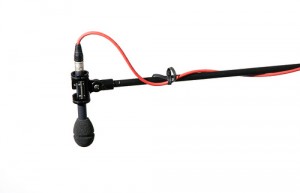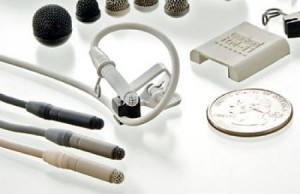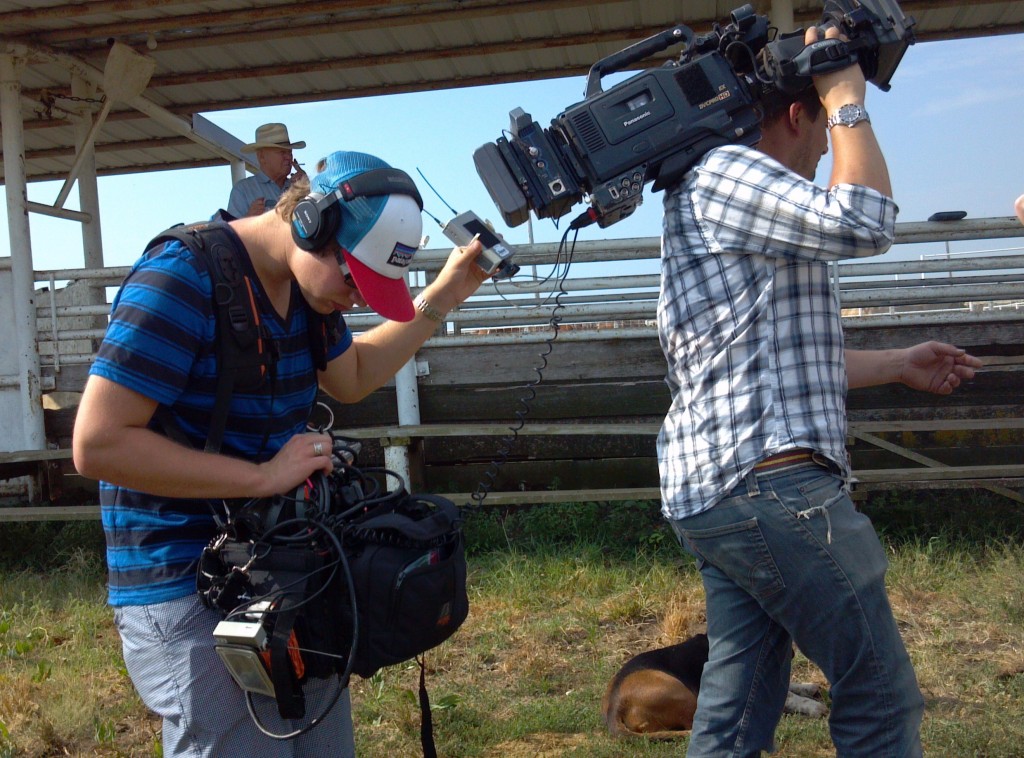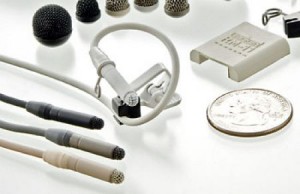 Ever wonder why sound mixers record and interview with both a lavalier mic and a boom microphone? The standard producer request, whenever an interview is recorded for television: Boom channel 1, lav channel 2, or visa-versa. Why 2 microphones for one sound source? The answer runs a little deeper than you may think. 20 or 30 years ago, 2 mics for a single interview was not done. The sound recordist chose his weapon, a lav or a boom, and recorded with that. The producer asked no questions. There was only one, recordable mono track anyway! Back in the news-film, documentary days, or anything that preceded video, the audio went to the mono Nagra track, or the single audio channel on whatever sound amplifier (Auricon, Cinema Products, etc) was driving a sound-on-film system. Not only were two mics unnecessary, there weren’t two audio tracks for two mics. Eventually, Two tracks of audio became available when 3/4” u-matic, stereo Nagra, or 1” field recording came into being. Yet two mics for a single-person interview was still hardly contemplated. Enter the days of Tabloid and Reality television. And, the need for low-cost programming to fill 80 channels of cable/satellite TV. The small army of production mixers across the US, in their lofty, revered, hard-earned union positions, were no longer enough in number to meet the demand for the forthcoming tidal wave of cheap television. However, there were plenty of young, inexperienced crew people flooding into the production work force, many never having picked up a boom pole or lavalier mic. They worked for cheap, learned by trial and error, clipping lavs on collars, happily chasing around cameras with their little mixers. Recording interviews with whatever audio gear the cameraman owned, or was thrown in the back of the truck. You can imagine what came next. Horrible audio came flooding into the edit bays. Poorly cued booms, lavs placed too low or too high, or no mic at all- when the new guy forgot to switch from the camera mic! If a mic battery died, or a location was noisy, the editor got what he got- 1 channel of crappy audio from one mic, recorded by a beginner. It didn’t take long for word to come down on high. Make those jobs idiot-proof, because we’ve got an army of idiots recording our field audio! Thus came the new protocol- record lavalier on 1 channel, and boom on the other. In Post, now we can choose the less horrible of the two! The senior sound guys balked- they knew how to get good interview audio with one mic, and no memo from above was going to tell them how to do the job. Regardless, the protocol stuck, and is still with us today. I don’t begrudge the method at all. Today, having both mics going makes sense in a fail-safe kind of way- most of the time. Also, for fun, we get to A/B our boom and lavs during the interview. The on-set mentality is: Get it right, get it in spades, and if you can, postpone making a decision about anything. Works for me! All I ask is: Please, Mr Editor, pick one or the other, and don’t mix the two down to mono! – by Pete Verrando www.txsound.com
Ever wonder why sound mixers record and interview with both a lavalier mic and a boom microphone? The standard producer request, whenever an interview is recorded for television: Boom channel 1, lav channel 2, or visa-versa. Why 2 microphones for one sound source? The answer runs a little deeper than you may think. 20 or 30 years ago, 2 mics for a single interview was not done. The sound recordist chose his weapon, a lav or a boom, and recorded with that. The producer asked no questions. There was only one, recordable mono track anyway! Back in the news-film, documentary days, or anything that preceded video, the audio went to the mono Nagra track, or the single audio channel on whatever sound amplifier (Auricon, Cinema Products, etc) was driving a sound-on-film system. Not only were two mics unnecessary, there weren’t two audio tracks for two mics. Eventually, Two tracks of audio became available when 3/4” u-matic, stereo Nagra, or 1” field recording came into being. Yet two mics for a single-person interview was still hardly contemplated. Enter the days of Tabloid and Reality television. And, the need for low-cost programming to fill 80 channels of cable/satellite TV. The small army of production mixers across the US, in their lofty, revered, hard-earned union positions, were no longer enough in number to meet the demand for the forthcoming tidal wave of cheap television. However, there were plenty of young, inexperienced crew people flooding into the production work force, many never having picked up a boom pole or lavalier mic. They worked for cheap, learned by trial and error, clipping lavs on collars, happily chasing around cameras with their little mixers. Recording interviews with whatever audio gear the cameraman owned, or was thrown in the back of the truck. You can imagine what came next. Horrible audio came flooding into the edit bays. Poorly cued booms, lavs placed too low or too high, or no mic at all- when the new guy forgot to switch from the camera mic! If a mic battery died, or a location was noisy, the editor got what he got- 1 channel of crappy audio from one mic, recorded by a beginner. It didn’t take long for word to come down on high. Make those jobs idiot-proof, because we’ve got an army of idiots recording our field audio! Thus came the new protocol- record lavalier on 1 channel, and boom on the other. In Post, now we can choose the less horrible of the two! The senior sound guys balked- they knew how to get good interview audio with one mic, and no memo from above was going to tell them how to do the job. Regardless, the protocol stuck, and is still with us today. I don’t begrudge the method at all. Today, having both mics going makes sense in a fail-safe kind of way- most of the time. Also, for fun, we get to A/B our boom and lavs during the interview. The on-set mentality is: Get it right, get it in spades, and if you can, postpone making a decision about anything. Works for me! All I ask is: Please, Mr Editor, pick one or the other, and don’t mix the two down to mono! – by Pete Verrando www.txsound.com
Tag Archives: lavalier

Mailbag- Lectrosonics SRb versus SRa+ Huh?
From the mailbag! Keep those cards and letters coming!Dave, from Sydney Austrailia, writes:
Hi.
I’m considering buying an upgrade SRa (serial # is above 105…)
Are yours upgraded? How have they performed? Do you know if they have the 6 layer board?
“The 80% improvement RF board is 17378-K. The full SRb board is 17378-L”
Thanks
Dave
Hi Dave!
I never owned 1st generation SRa’s so I don’t have anything to compare, but I’ve heard that range on those early SRa’s was pretty bad. That’s why everybody started buying RF amplifiers and sharkfin antennas to hang off their bags.
I never owned 1st generation SRa’s so I don’t have anything to compare, but I’ve heard that range on those early SRa’s was pretty bad. That’s why everybody started buying RF amplifiers and sharkfin antennas to hang off their bags.
Now that the SRb’s are available, those RF amps and Sharkfins will probably overload the front-ends of the SRb’s. Ha ha.
Update: I just took delivery on a used SRa- that is pre serial# 105… Before I get it upgraded, I want to do some comparisons between it and my post-105 SRa’s,.. Range tests are pretty simple, but selectivity comparisons are difficult to simulate and measure. I’ll probably just take their word on it, and continue to do good freq. coordination.
All the best!
Pete Verrando
Dallas TX
Hi Pete
Good to hear about your experience. I’ll test a ‘post-105’ or ‘SRa+’ (as Larry F named it) around town if the dealer will let it out for a day or two. Keen to hear how your comparisons go as well pre and post upgrade.
Cheers
Dave
Hi Dave!
Today I did a walk test comparison of my SRa to an “SRa+”. (same block) I used one SMV transmitter and tuned channel 1 on both receivers to the transmit frequency. I first noticed the open SRa 2nd channel (coordinated) was much more susceptible to swamping when the transmitter for channel 1 comes too close. The SRa+ showed no evidence of swamping on the 2nd, open channel.
In a walk test, the two receivers were pretty close in range in open air, but when I placed the transmitter inside a vehicle, the SRa lost it entirely, while the SRa+ was showing about 50% signal level.
Cheers! (Except I have a vodka martini in my hand)
Pete
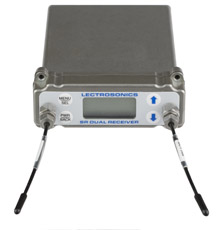 |
| The saga continues…. |
-by Pete Verrando

Lav Channel 1, Boom Channel 2, Please?
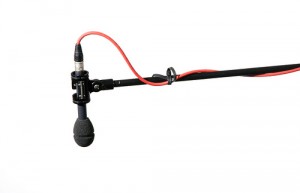 |
| Record Now, Decide Later. |
Ever wonder why interviews are recorded with both a lavalier mic and a boom microphone? The standard producer request, whenever an interview is recorded for television: Boom channel 1, lav channel 2, or visa-versa. Why 2 microphones for one sound source? The answer runs a little deeper than you may think.
20 or 30 years ago, two mics for a single interview was not done. The sound recordist chose his weapon, a lav or a boom, and recorded with that. The producer or director, or whoever was in charge, asked no questions. There was only one, recordable mono track anyway! Back in the news-film, documentary days, or anything that preceded video, the audio went to the mono Nagra track, or the single audio channel on whatever sound amplifier (Auricon, Cinema Products, etc) was driving a sound-on-film system. Not only were two mics unnecessary, there weren’t two audio tracks for two mics! Two tracks of audio eventually became available when 3/4” u-matic, stereo Nagra, or 1” field recording came into being. Yet two mics for a single-person interview was still hardly contemplated.
Enter the days of Tabloid and Reality television. And, the need for low-cost programming to fill 80 channels of cable/satellite TV. The tiny army of production mixers, in their lofty, revered, hard-earned union positions, were no longer enough in number, or even willing to meet the demand for the forthcoming tidal wave of cheap television.
However, there were plenty of young, inexperienced crew people flooding into the production work force, many never having picked up a boom pole or lavalier mic. They worked for cheap, learned by trial and error, clipping lavs on collars, happily chasing around cameras with their little mixers. Recording interviews with whatever audio gear the cameraman owned, or was thrown in the back of the truck. Often an Shure FP31 and two Sony ECM50’s…
You can imagine what came next. Horrible audio came flooding into the edit bays. Poorly cued booms, lavs placed too low or too high, or no mic at all- when the soundman forgot to switch from the camera mic, or connect the umbilicle. If a mic battery died, or a location was noisy, the editor got what he got– 1 channel of crappy audio from one mic, recorded by a beginner.
It didn’t take long for word to come down on high. Make those jobs idiot-proof, because we’ve got an army of idiots recording our field audio! Thus came the new protocol- record lavalier on 1 channel, and boom on the other. In Post, now we can choose the less horrible of the two! The senior sound guys balked– they knew how to get good interview audio with one mic, and no memo from above was going to tell them how to do the job. Regardless, the protocol stuck, and is still with us today. I don’t begrudge the method at all. Today, having both mics going makes sense in a fail-safe kind of way- most of the time. Let’s say you have 15 minutes to interview the King of Jordan. One take, no interruptions. Mid-interview, someone starts a vacuum cleaner in the next room. Would you rather have one mic choice or two? Afterwards, the producer’s inevitable question- how was that vacuum? Which mic sounded better? These days, the on-set mentality is: Get it right, get it in spades, and if you can, postpone making a decision about anything. Works for me! All I ask is: Please, Mr Editor, pick one or the other, and don’t mix the two down to mono!
– by Pete Verrando
www.txsound.com

